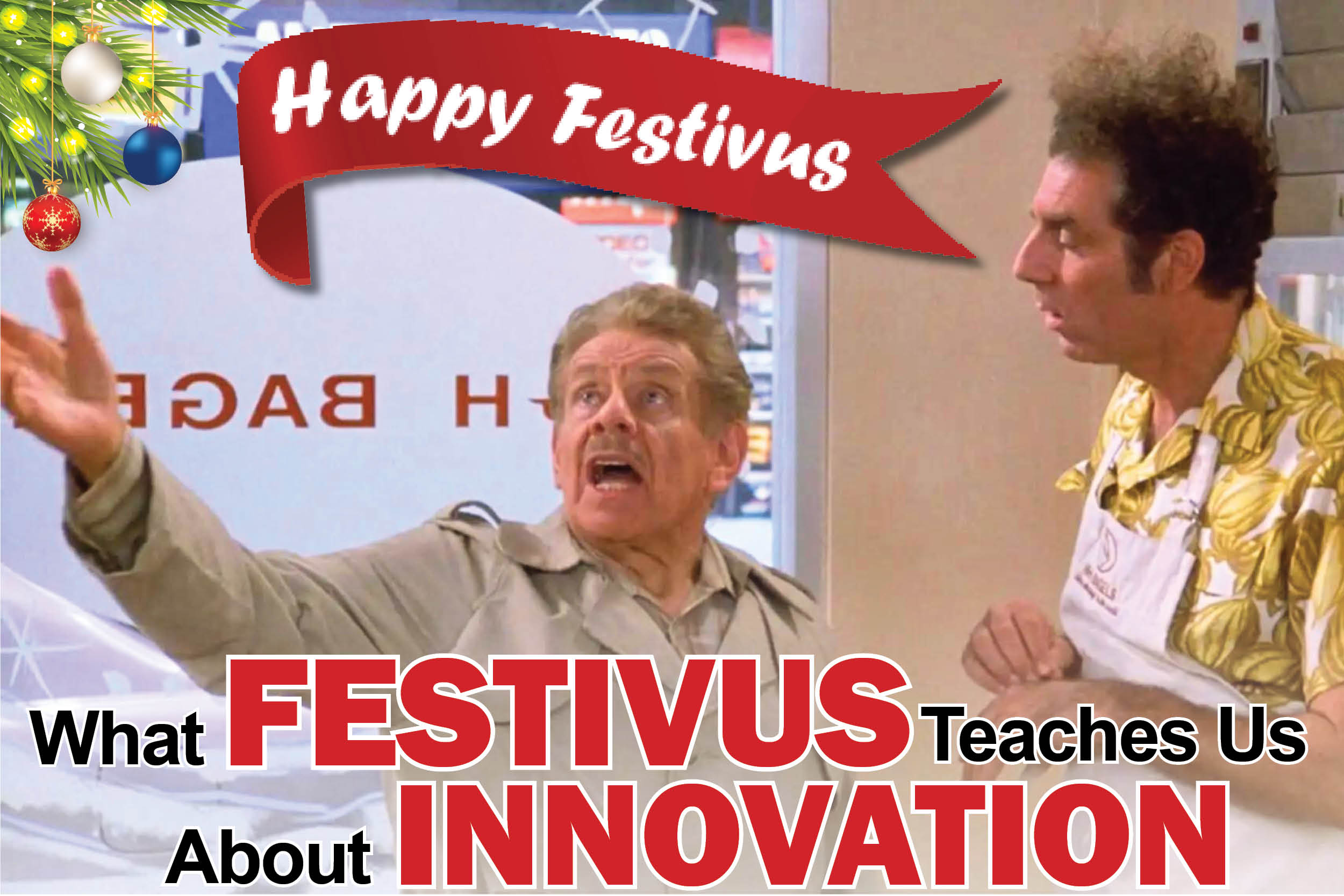
One of the most persistent challenges leaders face is securing their teams’ buy-in for new ideas, especially those that break away from the established norms. We may hold the vision for the future and feel responsible for pushing our organizations forward but achieving success hinges on our ability to get our team members on board.
Enter the timeless wisdom of Frank Constanza and the unconventional holiday celebration known as Festivus, as immortalized in the legendary sitcom Seinfeld. As an ardent Seinfeld enthusiast, I’ve always found solace and humor in the quirks of its characters and the hilariously mundane scenarios they navigate. One particularly iconic episode introduces us to Festivus, an “innovative” and somewhat rebellious holiday concocted by Frank.
Throughout the episode, Festivus becomes a symbol of innovation itself – a holiday for the rest of us, outside the norm. Though his methods may be unconventional and often elicit groans (George Costanza’s disdain for the holiday is a prime example), Frank’s unwavering dedication to change and his willingness to challenge the status quo offer valuable insights into getting your team to embrace new ideas.
Festivus-Inspired Secrets to Getting Your Team to Embrace New Ideas and Innovations
In the spirit of Festivus, let’s delve into the “Seinfeld” playbook and learn how to get our teams excited about the new and innovative, all while avoiding the pitfalls of Frank’s unconventional approach.
1. Focus on the “the why” more than the “yada yada yada.”
Leaders should first recognize the importance of explaining the “why” behind their new idea. Without the “why,” the what, how, and when can become just a bunch of “yada yada yada.” Go beyond simply discussing methods and outcomes. Instead, weave a compelling narrative that illuminates your proposed ideas’ broader vision and impact.
2. Forget the “one size fits all” approach and find ways to get personal buy-in.
Remember, leadership is like a Festivus dinner – it’s all about finding the right buttons to push. Leaders seeking personal buy-in from team members must embark on a journey of understanding individual motivations and connecting those to the proposed idea. This involves tailoring incentives based on the diverse preferences of team members, acknowledging that different individuals are motivated by various factors.
3. Avoid the “art of seduction” explanations and show people you’ve thought through the idea.
Leaders who want to establish credibility must present a well-researched and thoughtful foundation for the proposed idea. That’s why it’s essential to offer a solid base of research to showcase that you’ve thought through the concept and its potential implications. This involves conducting thorough research and examples that support the feasibility and possible success of the idea.
4. Don’t be like J. Peterman: Lead with transparency.
J. Peterman is known for his elaborate and poetic descriptions of products in his store’s catalog… and we all know how people felt about that. On the other hand, leaders who lead with transparency prioritize open communication regarding the potential successes and uncertainties associated with the idea. You should demonstrate vulnerability by admitting that not every aspect is foolproof, fostering a culture of honesty and trust within the team.
5. Identify key milestones and wins to avoid becoming one of Kramer’s “schemes.”
Embrace the wisdom of avoiding “Kramer’s schemes” by adopting a best practice to identify key milestones and wins before diving into a project. Much like Kramer’s outlandish plans that often crumble under the weight of spontaneity, recognize the value of meticulous planning. Break down your project into manageable milestones, each serving as a building block toward the grand vision.
6. Don’t be a Soup Nazi leader.
Just as the Soup Nazi denies customers their favorite soups without a moment’s consideration, leaders must avoid dismissing dissenting opinions outright. Instead, adopt a best practice that seeks to understand and honor the perspectives of skeptics and detractors. By acknowledging and respecting the questions raised by skeptics, leaders create an atmosphere of inclusivity and openness, transforming detractors into contributors and enriching the collaborative spirit within the team.
7. Celebrate like you’re hosting Festivus dinner.
It’s essential to regularly track the progress of your initiative and celebrate in meaningful ways. Milestones, even small ones, deserve a Festivus miracle of recognition. Like George celebrating his “Festivus feats of strength,” acknowledge and reward individual and team contributions. Consider how you can measure progress and create visuals that are easy for people to follow, such as a progress bar.
8. Remember, it’s not all about the airing of grievances.
While acknowledging challenges is important, don’t dwell on the negative. Focus on the positive progress, celebrate the team’s achievements, and keep everyone motivated by reminding them of the bigger picture. After all, who wants to remember Festivus for the airing of grievances when they can remember it for the time they achieved a Festivus miracle together?
By applying these ideas, leaders can create an environment where new ideas are not just tolerated, but enthusiastically embraced. So, as you embark on your own Festivus for innovation, may you navigate the workplace with the wisdom of Seinfeld, transforming challenges into comedic victories and fostering a culture where new and innovative ideas flourish. Happy Festivus for the Rest of Us!
By Kent Wilson
